When your red blood cell count is high, your blood becomes thicker and harder for your heart to pump through your body. This condition, called polycythemia or erythrocytosis, can happen for many different reasons and affects how well oxygen moves through your system.
A high RBC count makes your blood thicker, which increases your risk of blood clots, strokes, and heart attacks while potentially causing symptoms like fatigue, headaches, and dizziness. The elevated number of red blood cells circulating in the bloodstream[1] changes how your blood flows and can lead to serious health problems if not treated.
Your body might make too many red blood cells because of lung problems, sleep apnea, living at high altitudes, or certain diseases. Some people have genetic conditions that cause this problem. Understanding what happens when your RBC count is high helps you know when to see a doctor and what treatment options might work best.
Key Takeaways
- High RBC count thickens your blood and increases risks of blood clots, strokes, and heart problems
- Common symptoms include fatigue, headaches, dizziness, and weakness that may seem mild at first
- Treatment depends on the underlying cause and may include medications, lifestyle changes, or procedures to reduce blood thickness
Understanding Red Blood Cells and Their Role
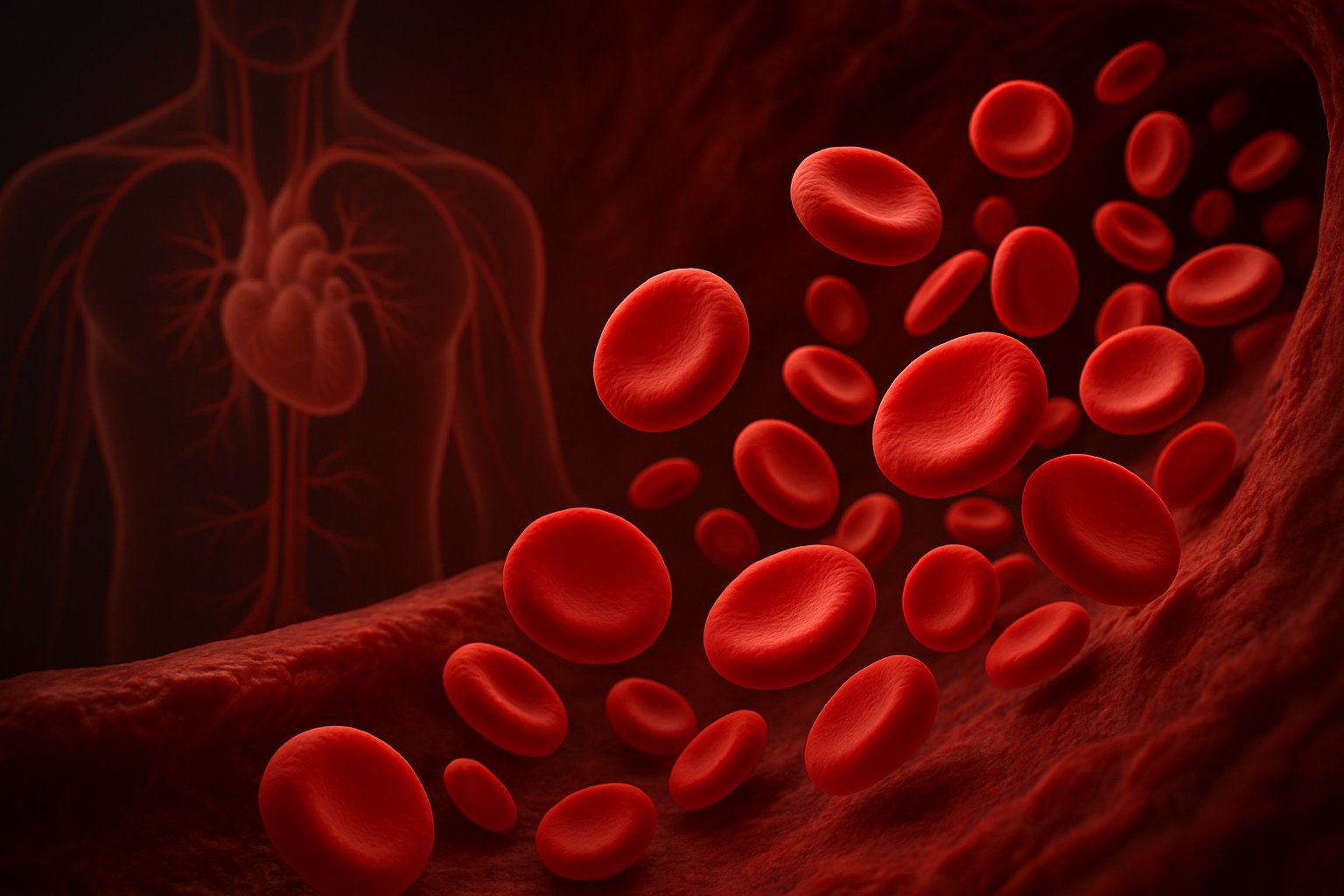
Red blood cells carry oxygen throughout the body and remove carbon dioxide waste. The bone marrow produces these cells continuously, with normal counts varying by age and gender.
Functions of Red Blood Cells
Red blood cells bring oxygen to tissues and release carbon dioxide to the lungs[2]. These cells contain hemoglobin, a protein that binds to oxygen molecules in the lungs.
When hemoglobin picks up oxygen, it turns bright red. The blood then travels through arteries to deliver oxygen to organs and muscles throughout the body.
After releasing oxygen, red blood cells collect carbon dioxide waste from tissues. They carry this waste back to the lungs where people breathe it out.
Key functions include:
- Transporting oxygen from lungs to body tissues
- Removing carbon dioxide waste from cells
- Maintaining proper pH balance in blood
- Supporting cellular energy production
Red blood cells have a unique shape that helps them move through tiny blood vessels. Their flexible, round design allows them to squeeze through the smallest capillaries to reach every part of the body.
Red Blood Cell Production
The body produces red blood cells in the bone marrow. This soft tissue inside bones creates about 17 million new red blood cells every second.
Erythrocytes develop from stem cells in a process that takes about seven days. The kidneys release a hormone called erythropoietin when oxygen levels drop in the blood.
This hormone signals the bone marrow to make more red blood cells. The process speeds up when the body needs extra oxygen, such as at high altitudes or during illness.
Red blood cells live for about 120 days before the spleen removes old ones from circulation. The body constantly replaces these cells to maintain healthy oxygen transport.
Iron, vitamin B12, and folate are essential nutrients for making healthy red blood cells. Without enough of these nutrients, the body cannot produce normal red blood cells.
Normal Red Blood Cell Count
Normal red blood cell counts vary between men and women. Adult males typically have 4.5-5.9 million cells per microliter while adult females have 4.0-5.2 million cells per microliter[3].
Normal RBC ranges:
| Group | Normal Range (million cells/μL) |
|---|---|
| Adult men | 4.5 – 5.9 |
| Adult women | 4.0 – 5.2 |
| Children | 4.0 – 5.5 |
These counts are measured through a complete blood count test. The test also measures hemoglobin levels and hematocrit, which shows the percentage of blood made up of red blood cells.
Normal ranges can vary slightly between different laboratories. Doctors consider a person’s age, gender, and overall health when interpreting results.
The plasma portion of blood carries red blood cells along with white blood cells and platelets. A proper balance of all blood components is necessary for good health.
What Is Considered a High RBC Count?
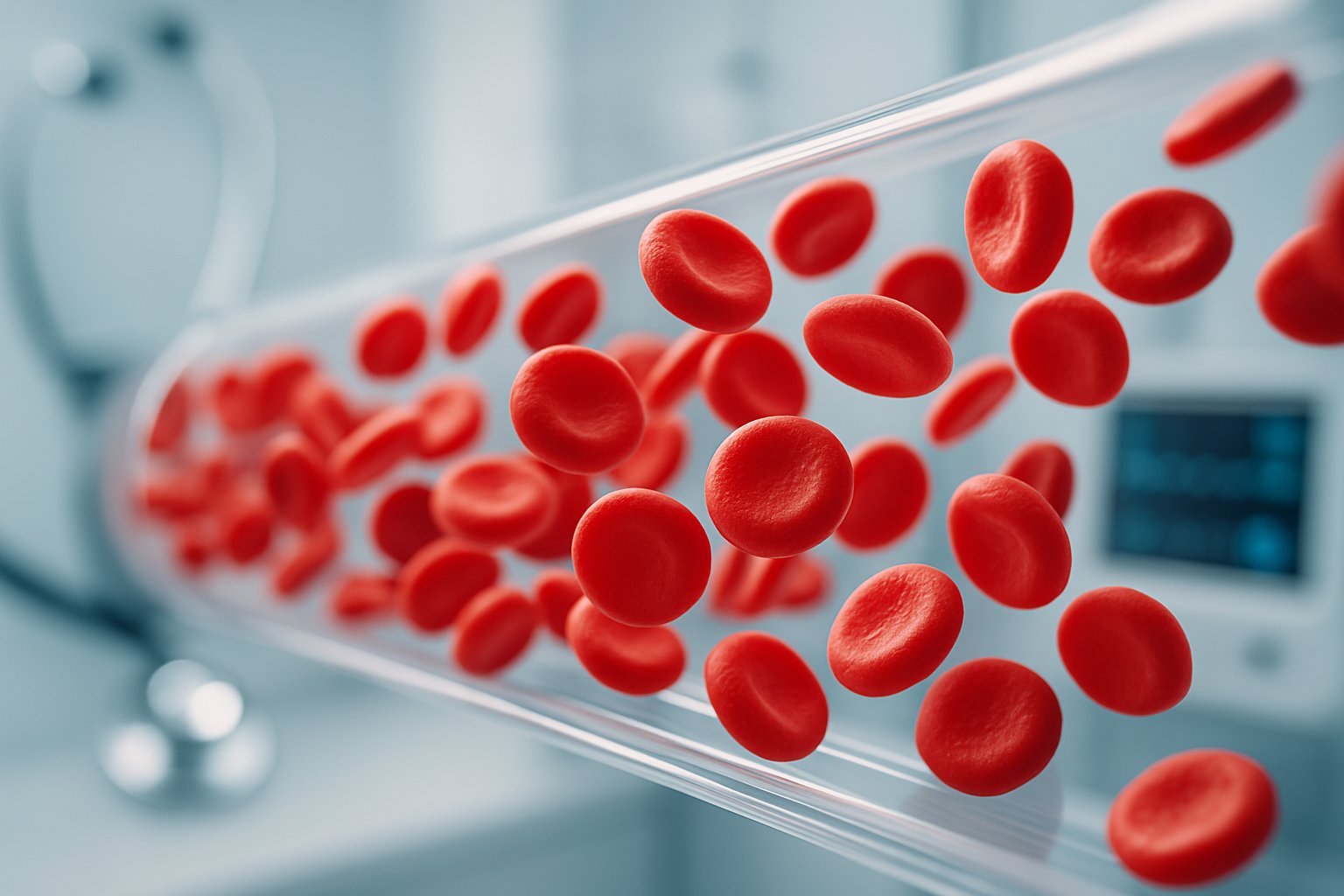
Healthcare providers use specific numbers to determine when red blood cell levels are too high. Normal ranges vary between men, women, and children, with measurements taken through standard blood tests.
Definition of High Red Blood Cell Count
A high red blood cell count means the number of red blood cells in the bloodstream is higher than normal[4]. This condition is also called erythrocytosis or polycythemia.
Red blood cells carry oxygen throughout the body. When someone has too many of these cells, their blood becomes thicker than normal.
This thickness can cause problems with blood flow. The extra red blood cells can make it harder for blood to move through small blood vessels.
How High RBC Count Is Measured
Doctors measure RBC count through a complete blood count (CBC) test. This is a routine blood test that checks different parts of the blood.
During the test, a healthcare provider takes a blood sample from a vein in the arm. They use a small needle to draw blood into a tube or container.
The RBC count is measured as part of a Complete Blood Count (CBC)[3]. The lab counts how many red blood cells are in each microliter of blood.
The test also measures hematocrit, which shows what percentage of blood is made up of red blood cells. Higher hematocrit levels can also signal high RBC count.
Normal Versus High Range
Normal red blood cell counts depend on age and gender. The ranges are measured in millions of cells per microliter of blood.
Normal RBC ranges:
- Men: 4.7 to 6.1 million cells per microliter
- Women: 4.2 to 5.4 million cells per microliter
- Children: 4.0 to 5.5 million cells per microliter
Numbers above these ranges suggest a high RBC count. Hemoglobin levels greater than 16.5 g/dL in women and greater than 18.5 g/dL in men suggest polycythemia[5].
Different labs may have slightly different normal ranges. The exact numbers can vary based on the testing method used.
Doctors look at both RBC count and hematocrit levels together. This gives them a clearer picture of whether red blood cell levels are too high.
Primary and Secondary Causes of High RBC Count
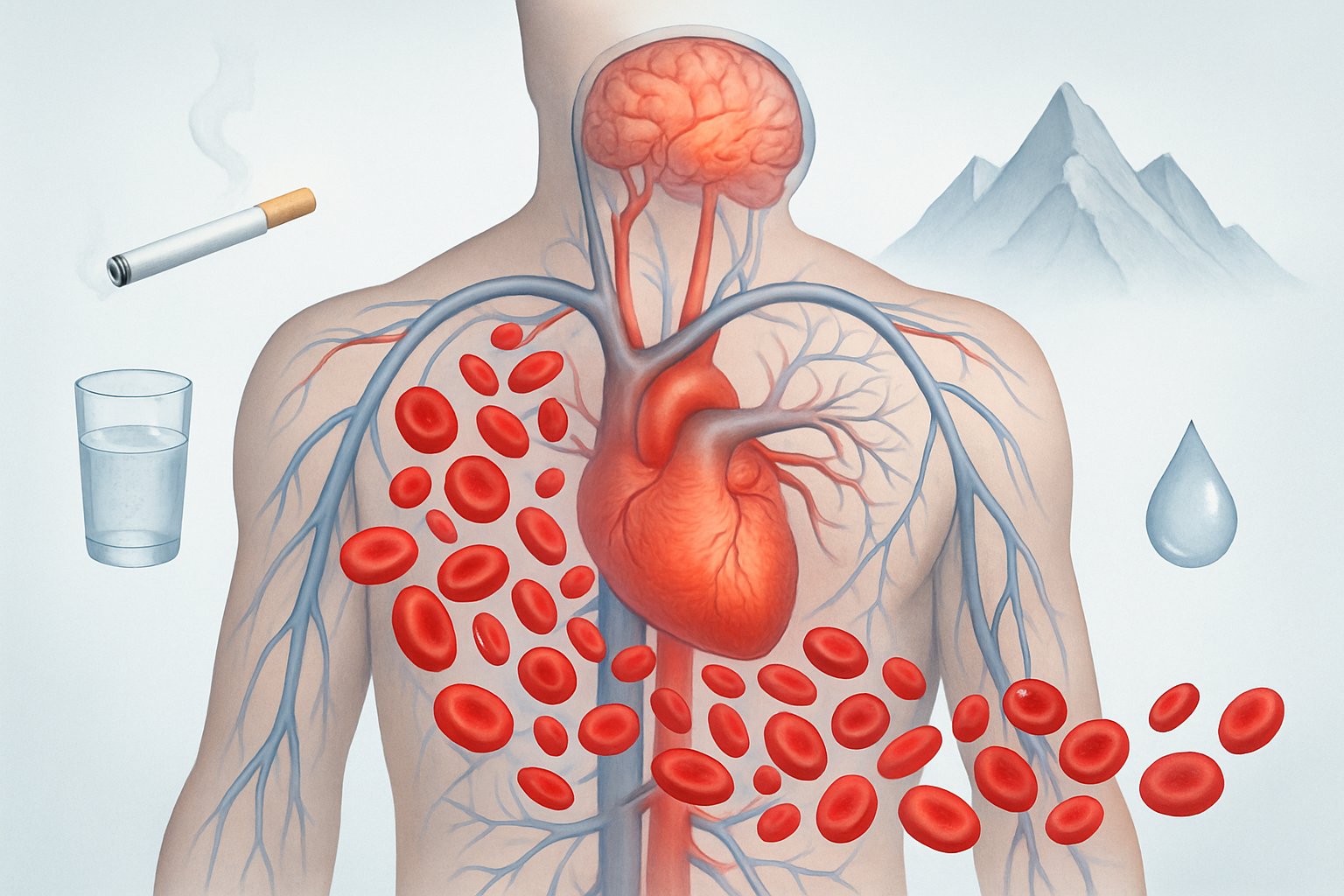
High RBC counts fall into three main categories based on their underlying causes. Primary erythrocytosis stems from bone marrow disorders, while secondary erythrocytosis results from external factors that trigger increased red blood cell production.
Primary Erythrocytosis
Primary erythrocytosis occurs when the bone marrow produces too many red blood cells without any external trigger. This happens due to genetic mutations or disorders within the blood-making cells themselves.
Polycythemia vera represents the most common form of primary erythrocytosis. This condition develops when a person inherits or develops mutations in the JAK2 gene, which controls red blood cell production.
About 95% of people with polycythemia vera carry the JAK2 V617F mutation. This genetic change causes bone marrow cells to produce red blood cells continuously, even when the body doesn’t need them.
Primary erythrocytosis also includes other rare bone marrow disorders. These conditions affect the stem cells that create all blood cells, leading to overproduction of red blood cells.
People with primary causes like polycythemia vera[3] often need lifelong treatment. The bone marrow continues making excess cells without proper regulation.
Secondary Erythrocytosis
Secondary erythrocytosis develops when outside factors cause the body to produce more red blood cells. The bone marrow itself works normally but responds to signals telling it to make more cells.
Low oxygen levels trigger most cases of secondary erythrocytosis. When tissues don’t get enough oxygen, the kidneys release erythropoietin (EPO), a hormone that tells bone marrow to produce more red blood cells.
Common causes include:
- Lung diseases like chronic obstructive pulmonary disease
- Heart conditions that reduce oxygen delivery
- Sleep apnea causing repeated oxygen drops
- Living at high altitudes where oxygen levels are lower
Kidney problems can also cause secondary erythrocytosis. Some kidney tumors produce too much erythropoietin, while kidney diseases can trigger EPO release.
Other causes include certain medications, smoking, and hormonal disorders. Heart disease and lung disease[4] represent frequent underlying conditions.
Relative Erythrocytosis
Relative erythrocytosis occurs when red blood cell concentration appears high but total red blood cell numbers remain normal. This happens when plasma volume decreases, making red blood cells more concentrated.
Dehydration causes the most common form of relative erythrocytosis. When people lose fluids through sweating, vomiting, or not drinking enough water, their blood becomes thicker.
The condition resolves quickly once fluid levels return to normal. Unlike true erythrocytosis, the bone marrow doesn’t produce extra red blood cells.
Other causes include:
- Severe burns leading to fluid loss
- Diuretic medications that remove excess water
- Alcohol use affecting fluid balance
Relative erythrocytosis requires different treatment than true erythrocytosis. Doctors focus on restoring proper fluid balance rather than reducing red blood cell production.
Common Underlying Conditions Leading to High RBC Count

Several medical conditions can trigger the body to produce too many red blood cells. These range from oxygen-related problems to serious diseases affecting the kidneys, lungs, and blood system.
Low Oxygen Levels
When the body doesn’t get enough oxygen, it responds by making more red blood cells. This happens because the kidneys sense low oxygen and release a hormone called erythropoietin.
High altitudes cause this problem most often. People who live above 8,000 feet have naturally higher RBC counts. Mountain climbers and pilots also experience this effect.
Sleep apnea blocks breathing during sleep. This creates periods of low oxygen that trigger extra red blood cell production. The condition affects millions of people and often goes undiagnosed.
Smoking damages the lungs and reduces oxygen levels in the blood. Heavy smokers frequently develop high red blood cell counts[4] as their bodies try to compensate.
Carbon monoxide poisoning also causes this response. The toxic gas prevents oxygen from binding to red blood cells properly.
Lung Disease and Chronic Conditions
Lung diseases make it hard for oxygen to enter the bloodstream. The body creates more red blood cells to carry whatever oxygen is available.
COPD (chronic obstructive pulmonary disease) blocks airflow in the lungs. Patients with severe COPD often develop elevated RBC counts over time.
Pulmonary fibrosis scars the lungs and prevents proper oxygen exchange. This rare condition typically affects older adults and can lead to significant increases in red blood cell production.
Other lung conditions that cause high RBC counts include:
- Severe asthma
- Lung infections
- Pulmonary hypertension
- Interstitial lung disease
Congenital heart disease can also trigger high RBC counts. When the heart doesn’t pump blood properly, tissues don’t get enough oxygen.
Kidney Problems
The kidneys control red blood cell production through erythropoietin hormone. When kidneys are damaged or diseased, they may produce too much of this hormone.
Kidney cancer sometimes causes tumors that release extra erythropoietin. This leads to elevated red blood cells[1] even when oxygen levels are normal.
Certain kidney diseases can also trigger overproduction. Polycystic kidney disease and renal artery stenosis are common examples.
Kidney transplant patients may develop high RBC counts too. This usually happens when the new kidney produces more erythropoietin than needed.
Dehydration affects kidney function and can temporarily raise RBC counts. Severe dehydration makes blood thicker and concentrates red blood cells.
Tumors and Blood Disorders
Some cancers and blood disorders directly affect red blood cell production in the bone marrow.
Blood cancers like leukemia can disrupt normal blood cell formation. Certain types cause the bone marrow to overproduce red blood cells.
Polycythemia vera is a blood disorder where the bone marrow makes too many red blood cells without any trigger. This condition increases the risk of blood clots and strokes.
Hemoglobinopathies are genetic disorders that affect hemoglobin. Some types cause the body to compensate by producing extra red blood cells.
Other blood disorders include:
- Essential thrombocythemia
- Primary myelofibrosis
- Hemoglobin variants
Liver tumors and certain brain tumors can also release hormones that stimulate red blood cell production. These cases are less common but require immediate medical attention.
Other Contributing Factors to Elevated RBC Count
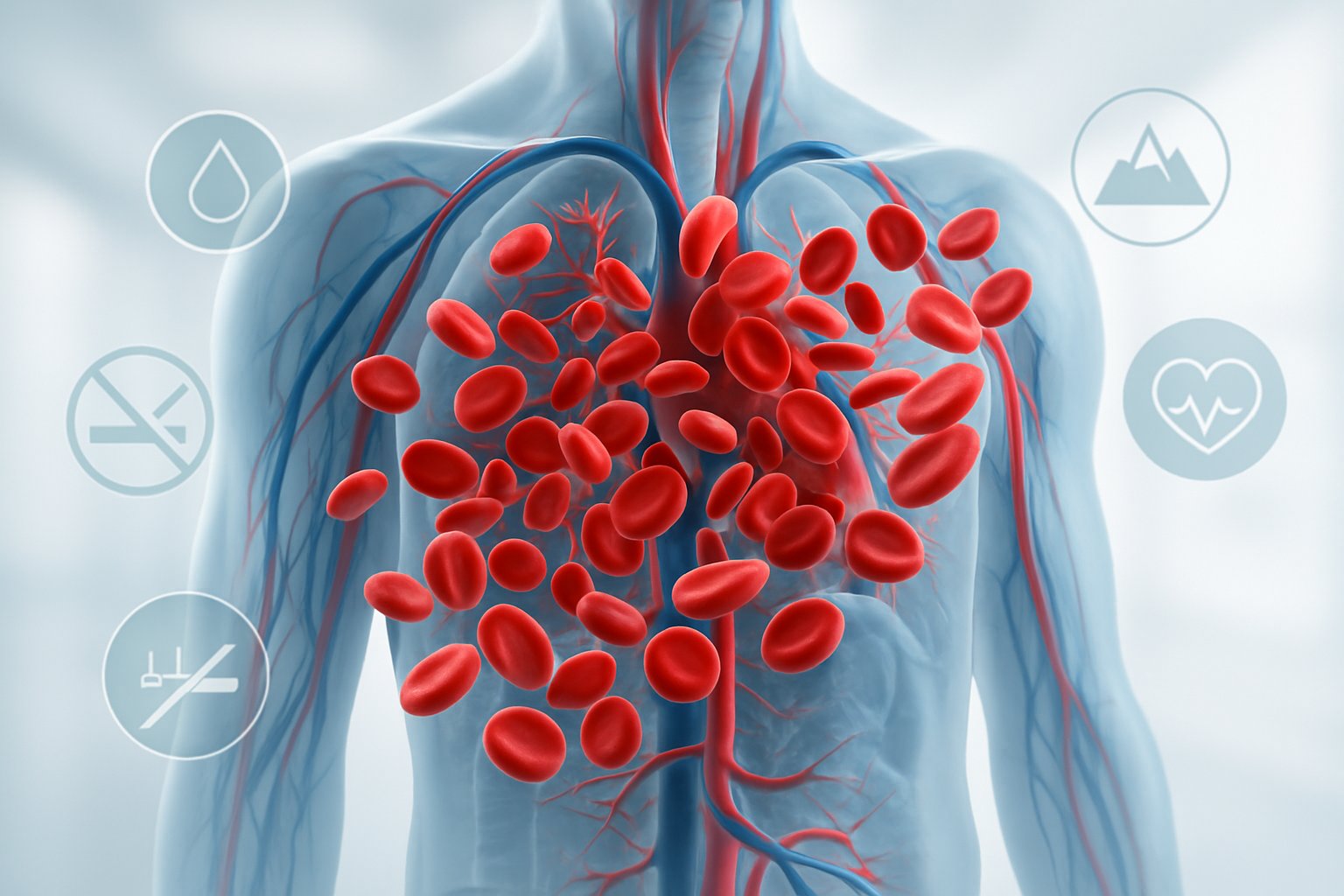
Several lifestyle and external factors can cause red blood cell counts to rise temporarily or chronically. Dehydration reduces blood volume[4], while certain medications and performance-enhancing substances directly stimulate red blood cell production.
Dehydration and Fluid Loss
When the body loses too much water, blood becomes more concentrated. This makes red blood cell counts appear higher than normal.
Common causes of dehydration include:
- Excessive sweating during exercise or hot weather
- Vomiting and diarrhea from illness
- Not drinking enough fluids throughout the day
- Fever that causes increased fluid loss
Athletes and outdoor workers face higher risks of dehydration. Their bodies lose large amounts of water through sweat.
Even mild dehydration can affect blood test results. The reduced plasma volume makes existing red blood cells more concentrated in each drop of blood.
Medication and Substance Effects
Several prescription medications can raise red blood cell production. Diuretics remove excess water from the body, which concentrates the blood similar to dehydration.
Blood pressure medications called diuretics work by increasing urination. This removes fluid but leaves red blood cells behind.
Testosterone replacement therapy stimulates bone marrow to produce more red blood cells. Men receiving this treatment need regular blood monitoring.
High-altitude medications help people adjust to low oxygen environments. They trigger the body to make extra red blood cells to carry more oxygen.
Smoking also affects red blood cell counts. Cigarettes reduce oxygen in the blood, causing the body to compensate by making more red blood cells.
Performance-Enhancing Drugs and Doping
Anabolic steroids and other banned substances artificially boost red blood cell production. These drugs create dangerously high levels that increase health risks.
Anabolic steroids mimic testosterone effects on bone marrow. They cause rapid increases in red blood cell counts within weeks of use.
EPO (erythropoietin) injections directly signal the body to make more red blood cells. Athletes use this hormone illegally to improve endurance performance.
Blood doping involves removing blood, storing it, then reinfusing it later. This temporarily increases the total number of red blood cells in circulation.
These methods create extremely high red blood cell counts. The thickened blood becomes difficult for the heart to pump and increases stroke risk significantly.
Symptoms and Effects of a High RBC Count
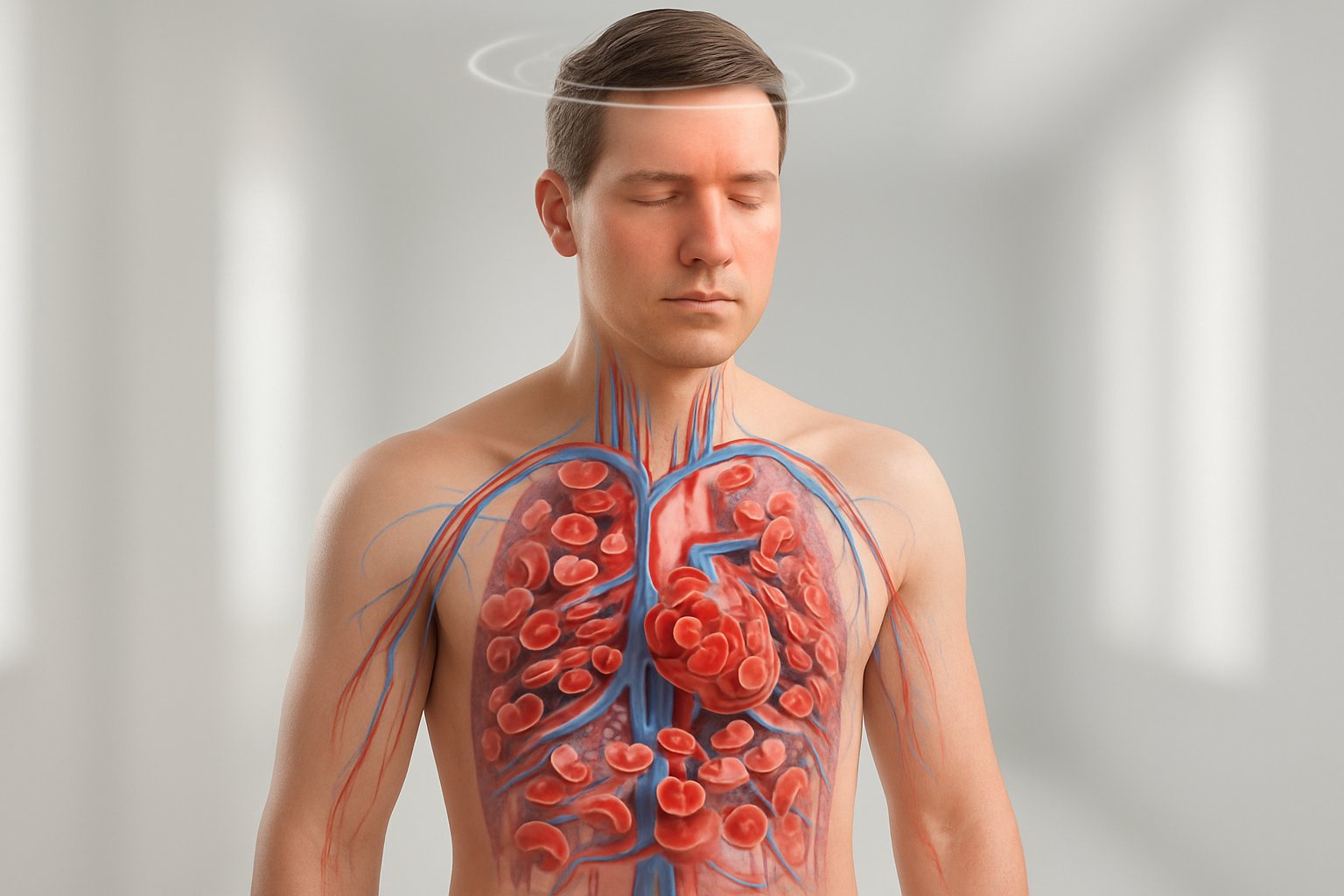
When red blood cell levels rise too high, the blood becomes thicker and flows less easily through vessels. This creates fatigue, dizziness, and headaches[3] along with skin changes and serious health risks like blood clots.
Circulatory and Neurological Symptoms
High RBC counts make blood thicker, which slows circulation throughout the body. The brain receives less oxygen despite having more red blood cells.
Common neurological symptoms include:
- Headaches that worsen over time
- Dizziness when standing or moving
- Confusion and difficulty concentrating
- Blurred vision from poor blood flow to the eyes
Circulatory effects cause:
- Weakness in arms and legs
- Tiredness that rest does not fix
- Poor exercise tolerance
The thick blood moves slowly through small vessels. This creates a cycle where tissues get less oxygen even though more red blood cells are present. Many people notice these symptoms develop gradually over weeks or months.
Skin, Vision, and Blood Pressure Changes
Thick blood affects the skin and creates visible changes. Blood vessels work harder to pump the heavy blood, raising pressure throughout the system.
Skin changes include:
- Itching that gets worse after hot showers or baths
- Red or purple color in the face and hands
- Easy bruising from minor bumps
High blood pressure develops as the heart pumps harder to move thick blood. This puts extra stress on blood vessel walls. Vision problems occur when blood flow to the eyes decreases.
Blood pressure effects:
- Steady rise in both systolic and diastolic numbers
- Nosebleeds from fragile blood vessels
- Ringing in the ears
The itching after showers[6] happens because warm water increases blood flow to already congested vessels.
Serious Complications and Risks
High RBC counts create dangerous blood clots because thick blood clumps together easily. These clots can block major blood vessels and cause life-threatening events.
Major risks include:
- Stroke from clots blocking brain blood vessels
- Heart attack when clots stop blood flow to the heart
- Deep vein thrombosis in leg veins
- Pulmonary embolism when clots reach the lungs
The body also produces more platelets along with extra red blood cells. This makes clotting even more likely. People with polycythemia vera often have bleeding problems or clotting events[6].
Emergency warning signs:
- Sudden weakness on one side of the body
- Difficulty speaking or understanding speech
- Severe chest pain or shortness of breath
- Leg swelling with pain and warmth
These complications can happen without warning. Regular monitoring and treatment help prevent these serious outcomes.
How High RBC Count Is Diagnosed
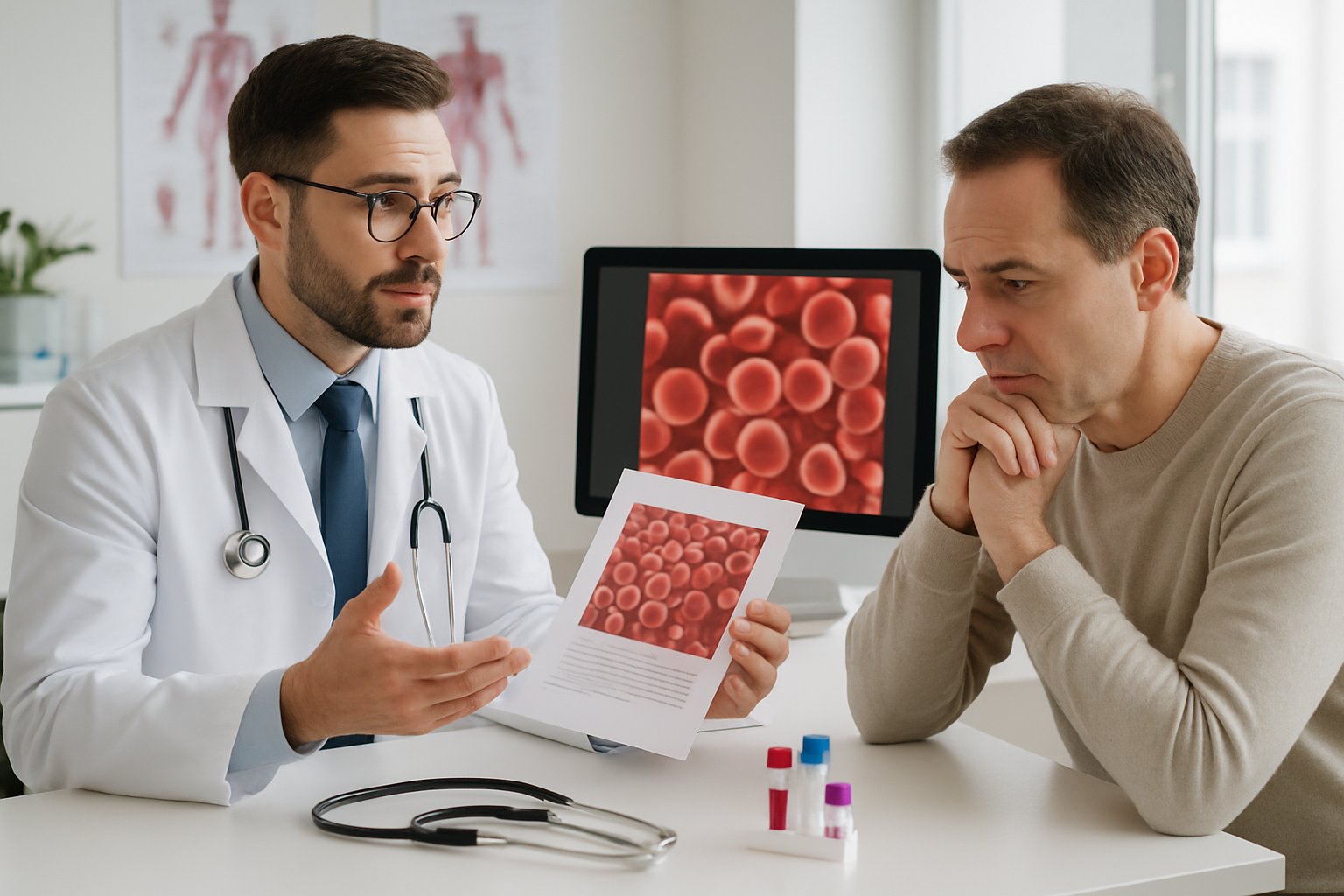
Doctors use blood tests and lab work to find high red blood cell counts. They may order more tests to figure out what’s causing the problem and track changes over time.
Blood Tests and Laboratory Assessments
A Complete Blood Count (CBC)[3] is the main test doctors use to check RBC levels. This blood test measures how many red blood cells are in a person’s blood sample.
The CBC also checks hematocrit and hemoglobin levels. Hematocrit shows what percentage of blood is made up of red blood cells. Hemoglobin measures the protein that carries oxygen in red blood cells.
Normal RBC counts vary by age and sex:
| Group | Normal RBC Count (per microliter) |
|---|---|
| Men | 4.7 to 6.1 million |
| Women | 4.2 to 5.4 million |
| Children | 4.0 to 5.5 million |
To get a blood sample, a nurse or lab worker puts a needle into a vein. They draw blood through a tube into a container. This process is called phlebotomy.
Additional Diagnostic Procedures
When blood tests show high RBC counts, doctors may order more tests. They look for conditions that cause the body to make too many red blood cells.
Doctors might test for the JAK2 gene mutation. This genetic change can cause certain blood disorders that lead to high RBC counts. The JAK2 mutation is found in many people with polycythemia vera.
Other tests may include checking oxygen levels in the blood. Low oxygen can make the body produce more red blood cells. Doctors also look for heart problems or sleep disorders that might reduce oxygen.
Bone marrow tests are sometimes needed. These tests check if the bone marrow is making too many blood cells. The doctor takes a small sample of bone marrow to examine under a microscope.
Monitoring and Follow-Up
People with high RBC counts need regular blood tests. Doctors track changes in red blood cell levels over time. This helps them see if treatment is working or if the condition is getting worse.
Follow-up visits usually happen every few months. The timing depends on how high the RBC count is and what’s causing it. Some people need monthly checks while others can wait longer.
Doctors also watch for symptoms that might develop. These include headaches, dizziness, or problems with blood clots. Regular monitoring helps catch any new problems early.
Treatment success is measured by how well RBC levels return to normal ranges. Doctors adjust treatment plans based on blood test results and how the patient feels.
Treatment and Management of High RBC Count

Treatment depends on whether the high count comes from an underlying condition or a primary blood disorder. The mainstay of therapy for polycythemia vera remains phlebotomy[5], while secondary cases focus on addressing root causes.
Managing Underlying Causes
Secondary polycythemia requires treating the condition that causes elevated RBC production. This approach targets the source rather than just the symptoms.
Respiratory Conditions Patients with chronic lung diseases like COPD or sleep apnea benefit from oxygen therapy. Supplemental oxygen helps reduce the body’s need to produce extra red blood cells.
Heart Problems Heart failure treatment improves oxygen delivery throughout the body. This reduces the signal to make more red blood cells.
High Altitude Effects People living at high elevations may need to relocate to lower altitudes. The body produces more RBCs to compensate for thin air.
Tumor Treatment Certain tumors secrete inappropriately high amounts of EPO[5], including liver and kidney cancers. Removing these tumors often normalizes RBC counts.
Lifestyle Modifications
Simple daily changes help manage symptoms and prevent complications from thick blood.
Hydration Staying well hydrated prevents concentrating the blood further[5]. Patients should drink plenty of water throughout the day.
Activity Restrictions Most people can continue normal physical activities. Those with enlarged spleens should avoid contact sports to prevent organ injury.
Dietary Changes Patients should avoid iron supplements as these promote more red blood cell production. A balanced diet without extra iron works best.
Smoking Cessation Stopping cigarette use reduces carbon monoxide exposure. This decreases the body’s drive to produce excess RBCs.
Medical Therapies
Primary polycythemia requires specific medical treatments to reduce blood thickness and prevent clots.
Phlebotomy Bloodletting keeps hematocrit around 45% in men and 42% in women[5]. Initial treatments remove 250-500 milliliters every 2-3 days.
Medication Options Hydroxyurea lowers all elevated blood counts[5] including white cells, red cells, and platelets. Doctors recommend it for patients over 70 or those with high platelet counts.
Blood Thinners Aspirin reduces clotting risk when used with other treatments. Doctors avoid it in patients with bleeding histories.
Monitoring Regular blood tests track treatment progress. Frequent monitoring ensures hematocrit levels stay within target ranges.
Prevention and When to Seek Medical Advice

Regular blood monitoring helps catch changes in red blood cell counts early. Knowing when to contact a doctor prevents complications from untreated high RBC levels.
Routine Monitoring
People should get a CBC blood test during their annual routine check-up to track red blood cell levels. This simple test shows if RBC counts are rising before symptoms appear.
Those with known risk factors need more frequent testing. Heart disease, lung problems, or sleep apnea require monitoring every 3-6 months.
High-risk individuals should watch for early warning signs:
- Headaches that won’t go away
- Dizziness or feeling lightheaded
- Blurred vision
- Fatigue despite getting enough sleep
A routine check-up can also screen for conditions like anemia, which sometimes occurs alongside other blood disorders. Regular testing helps doctors spot patterns in blood cell counts over time.
People taking medications that affect blood production need closer monitoring. Their doctors may order blood tests every few weeks to ensure levels stay normal.
When to Contact Your Healthcare Provider
Persistent or severe symptoms[7] require immediate medical attention. High RBC counts can cause blood to thicken and create dangerous clots.
Call a doctor right away for these symptoms:
- Severe headaches that feel different from usual headaches
- Chest pain or trouble breathing
- Sudden vision changes
- Numbness in arms or legs
- Severe dizziness or fainting
Mental changes or severe symptoms[8] need emergency care. These could signal blood clots affecting the brain or other vital organs.
People should also contact their healthcare provider if they notice gradual changes. Increased fatigue, frequent headaches, or ongoing dizziness may indicate rising RBC levels.
Don’t wait for symptoms to worsen. Early treatment prevents serious complications like stroke or heart attack from blood clots.
Frequently Asked Questions
People often wonder about specific symptoms they might experience and how age affects normal blood cell ranges. Many also want to know which health conditions cause these changes and what treatment options doctors typically recommend.
What are the symptoms associated with a high red blood cell count?
High red blood cell count symptoms[4] can include headaches, dizziness, and fatigue. Some people may experience shortness of breath or feel weak during daily activities.
Skin may appear flushed or red, particularly on the face and hands. Vision problems can occur, such as blurred sight or difficulty focusing.
Many people with elevated red blood cell counts show no symptoms at all. When symptoms do appear, they often develop slowly over time and may be mild at first.
How might high red blood cell counts vary with different age groups?
Normal red blood cell ranges differ between children and adults. Children typically have counts between 4.0 and 5.5 million cells per microliter[3] of blood.
Adult men have higher normal ranges than women. Men typically range from 4.7 to 6.1 million cells per microliter, while women range from 4.2 to 5.4 million.
Older adults may be more likely to develop high red blood cell counts due to certain medications or chronic health conditions. Age-related changes in kidney function can also affect red blood cell production.
What medical conditions are frequently linked to elevated red blood cell levels?
Heart failure can cause the body to produce more red blood cells as it tries to deliver more oxygen to tissues. Sleep apnea also triggers increased production because oxygen levels drop during sleep.
Lung diseases like chronic obstructive pulmonary disease reduce oxygen in the blood. The body responds by making more red blood cells to carry available oxygen.
Polycythemia vera represents a type of cancer[9] that causes bone marrow to produce too many red blood cells. Kidney tumors or cysts can also release hormones that stimulate red blood cell production.
Are there lifestyle factors that can contribute to increasing red blood cell counts?
Living at high altitudes naturally increases red blood cell production. The body makes more cells to handle lower oxygen levels in mountain environments.
Smoking reduces oxygen delivery to tissues and can trigger increased red blood cell production. Dehydration can also make red blood cell counts appear higher by concentrating the blood.
Certain performance-enhancing drugs and testosterone therapy can stimulate red blood cell production. Heavy alcohol use may also affect blood cell counts over time.
What are the potential implications of a high red blood cell count during pregnancy?
Pregnancy normally causes blood volume to increase, which can dilute red blood cell concentration. This makes high red blood cell counts during pregnancy particularly concerning.
Elevated counts can increase the risk of blood clots, which pose serious dangers during pregnancy and delivery. Poor blood flow to the placenta may affect the baby’s growth and development.
Pregnant women with high red blood cell counts need close monitoring by their healthcare team. Treatment may be necessary to protect both mother and baby from complications.
What are common interventions to manage an elevated red blood cell count?
Phlebotomy involves removing blood from the body through a needle, similar to blood donation. This procedure directly reduces the number of red blood cells in circulation.
Doctors may prescribe medications to slow down red blood cell production in the bone marrow. These treatments help maintain counts within normal ranges over time.
Treating underlying conditions often helps normalize red blood cell counts naturally. Managing heart disease, sleep apnea, or other health problems can reduce the body’s need to produce extra cells.
References
- Top 10 Reasons for a High Red Blood Cell Count You Should Know. https://www.manipalhospitals.com/gurugram/blog/reasons-for-high-red-blood-cell-count/ Accessed October 31, 2025
- Red Blood Cells: Function, Role & Importance. https://my.clevelandclinic.org/health/body/21691-function-of-red-blood-cells Accessed October 31, 2025
- High RBC Count Explained: What It Means and What to Do Next. https://www.rupahealth.com/post/high-rbc-count-explained-what-it-means-and-what-to-do-next Accessed October 31, 2025
- High Red Blood Cell Count: Symptoms, Meaning, Causes. https://my.clevelandclinic.org/health/symptoms/17810-high-red-blood-cell-count Accessed October 31, 2025
- High Red Blood Cell Count (Polycythemia): Symptoms & Treatment. https://www.emedicinehealth.com/polycythemia_high_red_blood_cell_count/article_em.htm Accessed October 31, 2025
- Polycythemia Causes, Symptoms, Diagnosis, Treatment. https://www.medicinenet.com/polycythemia_high_red_blood_cell_count/article.htm Accessed October 31, 2025
- 5 Warning Signs of Serious Illnesses in Adults. https://www.medanta.org/patient-education-blog/serious-illnesses-in-adults-warning-signs-how-to-recognize-disease-symptoms-seek-treatment Accessed October 31, 2025
- When to Call For Help. https://www.hopkinsmedicine.org/health/wellness-and-prevention/when-to-call-for-help Accessed October 31, 2025
- 403 Forbidden. https://www.apollohospitals.com/diseases-and-conditions/high-red-blood-cell-count-symptoms-causes-prevention-treatment Accessed October 31, 2025
